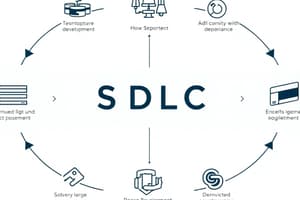Podcast
Questions and Answers
Which of the following describes the primary goal of good software?
Which of the following describes the primary goal of good software?
- To maximize the complexity of the underlying code.
- To provide high-quality services in a user-friendly environment. (correct)
- To abstract away the need for user interaction.
- To minimize the number of processes involved in development.
What is the role of Software Requirement Specification (SRS) in software development?
What is the role of Software Requirement Specification (SRS) in software development?
- It is a document created after the software is fully developed, detailing its features.
- It is the initial stage where developers write the code without any prior planning.
- It is created after developers complete testing and acceptance, just before deployment.
- It is based on business requirements gathered by a business analyst and used by the development team (correct)
Which of the following best describes the relationship between software and a software product?
Which of the following best describes the relationship between software and a software product?
- A software product is the initial version of code, while software refers to the updated and improved version.
- Software and software product are synonymous terms and can be use interchangeably.
- Software is the executable code; a software product includes code, libraries, and documentation tailored to a specific requirement. (correct)
- Software is always specific to a requirement, while a software product is a general term for any program.
What does 'engineering' contribute to the field of software development, resulting in 'software engineering'?
What does 'engineering' contribute to the field of software development, resulting in 'software engineering'?
What is the primary focus of 'software evolution'?
What is the primary focus of 'software evolution'?
Why is re-creating software from scratch not always a feasible solution when requirements change?
Why is re-creating software from scratch not always a feasible solution when requirements change?
Which of the following describes 'software paradigms' in the context of software engineering?
Which of the following describes 'software paradigms' in the context of software engineering?
How do software development, design, and programming paradigms relate to each other?
How do software development, design, and programming paradigms relate to each other?
Why is software engineering important considering the dynamic nature of software?
Why is software engineering important considering the dynamic nature of software?
Which of the following factors contributes to the need for software engineering?
Which of the following factors contributes to the need for software engineering?
What does the 'operational' characteristic of good software refer to?
What does the 'operational' characteristic of good software refer to?
What does the 'transitional' characteristic of good software primarily address?
What does the 'transitional' characteristic of good software primarily address?
What does the term 'maintenance' refer to when discussing the characteristics of good software?
What does the term 'maintenance' refer to when discussing the characteristics of good software?
In the Software Development Life Cycle (SDLC), what is the purpose of the 'Communication' phase?
In the Software Development Life Cycle (SDLC), what is the purpose of the 'Communication' phase?
What is the main goal of the 'Requirement Gathering' phase in SDLC?
What is the main goal of the 'Requirement Gathering' phase in SDLC?
What does the 'Feasibility Study' determine in the SDLC?
What does the 'Feasibility Study' determine in the SDLC?
Which activity is included in the 'System Analysis' phase of the SDLC?
Which activity is included in the 'System Analysis' phase of the SDLC?
In the context of SDLC, what happens during the 'Integration' phase?
In the context of SDLC, what happens during the 'Integration' phase?
What is the key characteristic of the Waterfall model in software development?
What is the key characteristic of the Waterfall model in software development?
What is a key advantage of the iterative model in software development?
What is a key advantage of the iterative model in software development?
Flashcards
Software Engineering
Software Engineering
An engineering branch associated with development of software products using well-defined scientific principles, methods and procedures.
Software Evolution
Software Evolution
The process of developing a software product using software engineering principles and methods, which includes the initial development and maintenance of software.
Software Paradigms
Software Paradigms
Methods and steps taken while designing software, which can be combined into various categories.
Software Development Paradigm
Software Development Paradigm
Signup and view all the flashcards
Software Design Paradigm
Software Design Paradigm
Signup and view all the flashcards
Programming Paradigm
Programming Paradigm
Signup and view all the flashcards
Need of Software Engineering
Need of Software Engineering
Signup and view all the flashcards
Software Development Life Cycle (SDLC)
Software Development Life Cycle (SDLC)
Signup and view all the flashcards
SDLC Activities
SDLC Activities
Signup and view all the flashcards
Communication (in SDLC)
Communication (in SDLC)
Signup and view all the flashcards
Requirement Gathering
Requirement Gathering
Signup and view all the flashcards
Feasibility Study
Feasibility Study
Signup and view all the flashcards
System Analysis
System Analysis
Signup and view all the flashcards
Software Design
Software Design
Signup and view all the flashcards
Coding
Coding
Signup and view all the flashcards
Testing
Testing
Signup and view all the flashcards
Integration
Integration
Signup and view all the flashcards
Implementation
Implementation
Signup and view all the flashcards
Waterfall Model
Waterfall Model
Signup and view all the flashcards
Iterative Model
Iterative Model
Signup and view all the flashcards
Study Notes
- Software engineering ensures quality service in a user-friendly environment, abstracting complexity for ease of use.
- Building complex software involves intricate processes beyond just coding.
- A business analyst gathers business requirements, after which a development team creates a Software Requirement Specification (SRS).
- The process includes testing, acceptance, deployment, and maintenance, following the Software Development Life Cycle (SDLC).
Introduction to Software Engineering
- Software engineering combines software and engineering principles.
- Software is more than program code; it's executable code serving a computational purpose.
- Engineering involves developing products with well-defined scientific principles.
- A software product meets specific requirements.
- Software engineering develops software products using defined scientific methods, yielding efficient and reliable results.
Software Evolution
- Software evolution uses software engineering to develop a product, including initial development, maintenance, and updates, to meet requirements.
- Evolution starts with requirement gathering, followed by developers creating a prototype for user feedback early in development.
- Users suggest changes, leading to updates and maintenance, evolving the software.
- Changes are made to align existing software with the newest needs, instead of being recreated.
Software Paradigms
- Software paradigms are methods and steps for software design.
- These paradigms can be combined into categories, with each being contained in another.
- The programming paradigm is a subset of the software design paradigm, which is a subset of the software development paradigm.
Software Development Paradigm
- This involves applying engineering concepts to software development, including research and requirement gathering.
- Requirement gathering, software design, and programming are included in this paradigm.
Software Design Paradigm
- A part of software development includes design, maintenance, and programming.
Programming Paradigm
- This paradigm relates closely to the programming aspect of software development.
- Coding, testing, and integration are included in this paradigm.
Need for Software Engineering
- Software engineering is needed because of changing user needs and environments.
- It applies a scientific process to large software development.
- Without scientific concepts, recreating software would be easier than scaling existing software.
- Proper processes maintains the cost, despite lowering computer and electronic hardware prices.
- Software engineering facilitates enhancements necessary to adapt software to changing user environments.
- A better process provides a better and quality software product.
Characteristics of Good Software
- Judged by its offerings and usability, good software must be operational, transitional, and maintainable.
- Well-engineered has many characteristics, including effectiveness and efficiency
Operational Aspects
- Measures how well software functions, including areas of budget, usability, efficiency, correctness, functionality, dependability, security, and safety.
Transitional Aspects
- Important when software is moved across platforms, measuring portability, interoperability, reusability, and adaptability.
Maintenance Aspects
- Capabilities to maintain itself in a changing environment, looking at modifiability, maintainability, flexibility, and scalability
- Software engineering uses defined concepts to produce efficient, durable, scalable, on-time, in budget software.
Software Development Life Cycle
- Software Development Life Cycle (SDLC) provides well-defined and structured stages for software development.
SDLC Activities
- Provides a series of steps to design and develop software efficiently.
- Communication begins when a user requests a software product, negotiates terms with a service provider, and submits a written request.
Requirement Gathering
- The software development team works to understand the project and gathers information from stakeholders to define requirements.
- Requirements are classified into user, system, and functional, collected through studying systems, conducting interviews, and referring to databases or questionnaires.
Feasibility Study
- The team assesses whether the software can meet user needs and if the project is viable.
- It involves evaluating if the organization can undertake the project financially, practically, and technologically.
System Analysis
- Developers create a roadmap and choose a suitable software model, understanding product limitations and impacts.
- Assessing the project's scope and planning resources in advanced.
Software Design
- Requirements and analysis are used to design the software, creating logical and physical designs.
- Engineers produce metadata, data dictionaries, and diagrams.
Coding
- Also known as the programming phase, error-free executable programs make the software design implementation efficient.
Testing
- 50% of the development is for testing, ensuring critical level errors are removed.
- The process includes module, program, and product testing, with early discovery of errors being vital for reliable software.
Integration
- Integration happens by incorportating outer world entities
- This Involves libraries, databases, and/or software
Implementation
- Software is installed on user machines, with post-installation configurations and testing to solve portability, adaptability, and integration of related issues.
Operation and Maintenance
- The phase confirms the more efficient operation of the software with less errors.
- Training & documentation is used on how to keep it operational.
- Code updates and is maintained per ever changing user environment.
Disposition
- This involves archiving data and software components, closing down the system, planning closing activity and terminate timing.
Software Development Paradigm
- This helps developers choose a strategy and determine SDLC for software development.
Waterfall Model
- The Waterfall model means all SDLC will operate in a linear manner.
- The model assumes everything is perfectly planned and has no need to think about past mistakes that may arise.
- This model benefits developers that have designed already similar software and domain.
Iterative Model
- Software process projects are developed in repeating cycles after each step.
- The small scale is developed 1st and all those steps are considered.
- Afterwards more and more features are put into the software.
Spiral Model
- A combination of both iterative and SDLC projects.
V - Model
- Provides means of testing software at each stage in reverse.
- Test plans and test cases verify the validity of product according standard requirements.
- Validity of software is made visible at this stage.
Big Bang Model
- Little planning while using lots of programming and funds and it being based off the big bang of the universe.
- This results in the best software product and very little planning is needed.
- Not following the needs results in customer uncertainty and is arbitrary.
- Its a good method for experimenting and learning but large models should not do it.
Summary
- The point of Software engineering is not a new practice but a new basis as the need for software products grows.
- Ensures it all runs properly.
- In addition, less money and loss of reputation and even loss of life could be a result.
Studying That Suits You
Use AI to generate personalized quizzes and flashcards to suit your learning preferences.




